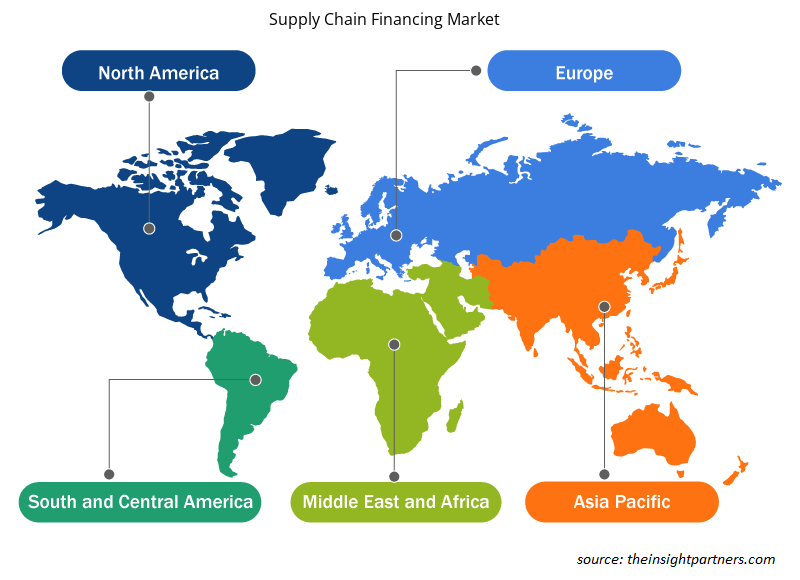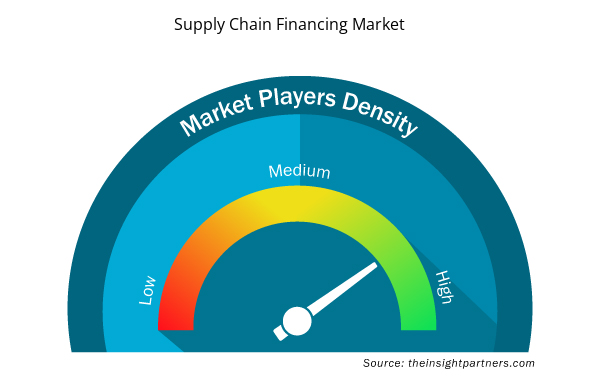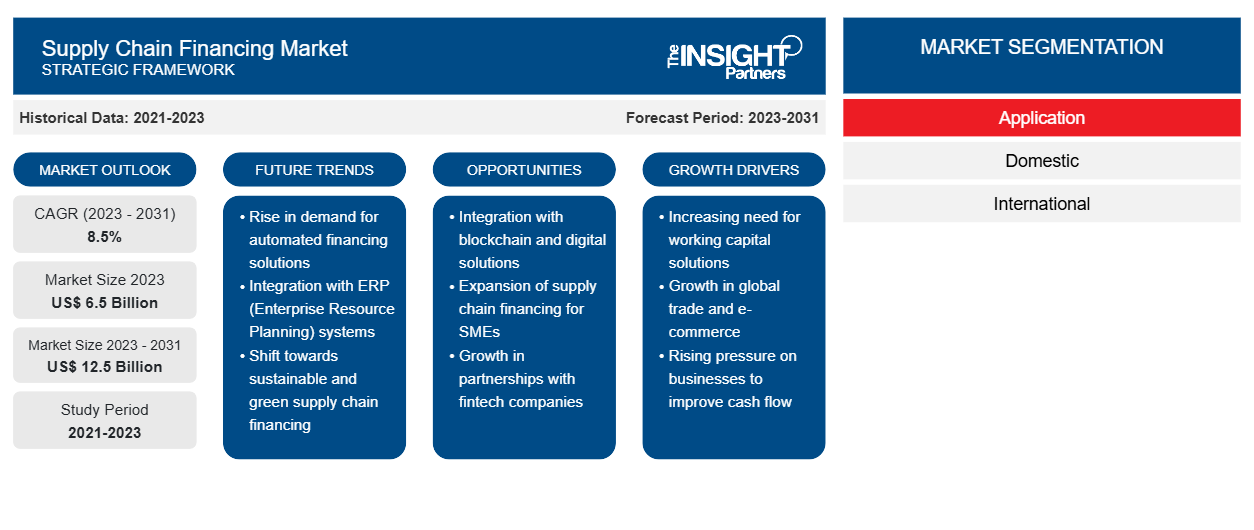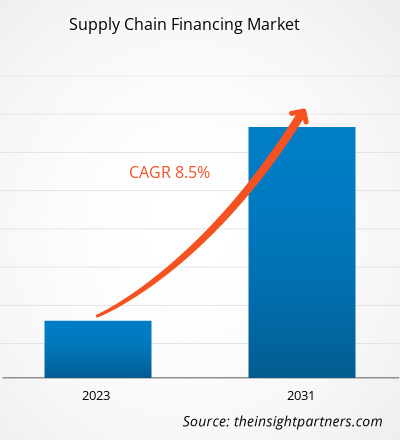サプライチェーンファイナンスの市場規模は、2023年の65億米ドルから2024年には10億米ドルに成長すると予想されています。 2031年までに125億ドルに達し、2023年から2031年にかけて年平均成長率8.5%で拡大すると予想されています。業界の市場成長は、資金調達コストの低下と効率性の向上、グローバル化とサプライチェーンのリスク、運転資本管理の必要性の高まりなど、さまざまな要因によって推進されています。
サプライチェーンファイナンス市場分析
サプライチェーン ファイナンス市場を牽引する要因はいくつかあります。まず、サプライ活動における安全性とセキュリティの必要性が高まっており、サプライチェーン ファイナンス ソリューションの需要が高まっています。この安全性とセキュリティの必要性は、混乱や不確実性が日常的である現在のビジネス環境では特に顕著です。次に、発展途上国の中小企業 (SME) によるサプライチェーン ファイナンスの導入が市場の成長に貢献しています。SME は、財務業務の改善と競争力の強化におけるサプライチェーン ファイナンスの利点を認識しています。
要件に合わせてレポートをカスタマイズする
このレポートの一部、国レベルの分析、Excelデータパックなど、あらゆるレポートを無料でカスタマイズできます。また、スタートアップや大学向けのお得なオファーや割引もご利用いただけます。
- このレポートの主要な市場動向を入手してください。この無料サンプルには、市場動向から見積もりや予測に至るまでのデータ分析が含まれます。
サプライチェーンファイナンス業界の概要
- サプライ チェーン ファイナンスは、サプライヤー ファイナンスまたはリバース ファクタリングとも呼ばれ、サプライ チェーン活動に携わる企業のキャッシュ フローと運転資本を最適化する金融ソリューションです。
- これには、購入者、サプライヤー、金融機関を結び付けて資金調達コストを下げ、キャッシュフローの効率を高め、リスクを軽減する一連のテクノロジーベースのプロセスが含まれます。サプライ チェーン ファイナンスでは、購入者は通常、販売者よりも高い信用格付けを持っているため、金融機関から低コストで資本にアクセスできます。
- この利点により、買い手は売り手と支払いスケジュールの延長など、より良い条件を交渉することができます。一方、売り手は仲介金融機関から即時の支払いを受けることができるため、製品をより早く処分することができます。サプライ チェーン ファイナンスの目標は、買い手と売り手の両方に短期クレジットを提供し、運転資金を最適化することです。サプライ チェーン ファイナンスは、サプライヤーが請求書の早期支払いを受けられるようにし、サプライ チェーンの混乱のリスクを軽減し、財務の安定性を向上させます。買い手は、運転資金の増加とサプライヤーとの関係強化の恩恵を受けます。
サプライチェーンファイナンス市場の推進力
サプライチェーンファイナンス市場を牽引する供給活動の安全性とセキュリティに対するニーズの高まり
- サプライ チェーン ファイナンス市場の成長を牽引する主な要因はいくつかあります。まず第一に、安全性とセキュリティに対するニーズの高まりが、サプライ チェーン ファイナンス市場の成長拡大に貢献しています。
- サプライ チェーン ファイナンスの需要は、投資家の信頼の喪失、市場の健全性の損なわれ、不正行為、金融機関に対して、より優れたデータ収集、監視機能、財務セキュリティを提供するサプライ チェーン ファイナンス手法への投資を求める圧力などの要因を含む市場操作により増加しています。国際貿易の初期の頃、輸出業者は輸入業者が商品の代金を支払うかどうかについて不確実性に直面していました。
- 対照的に、輸入業者は、商品の出荷が保証されないまま支払いを行うことを懸念していました。サプライチェーン ファイナンスは、輸出業者への支払いを迅速化し、信用状を通じて輸入業者を保証することで、これらのリスクに対処するように進化しました。競合他社に先んじるために、サプライチェーン ファイナンス プロバイダーは、投資家のインターフェイス エクスペリエンスを強化するソリューションをさらに導入しています。サプライチェーン活動における安全性とセキュリティへの注目が高まることで、サプライチェーン ファイナンス市場の予測に新たな機会がもたらされると予想されます。
サプライチェーンファイナンス市場レポートのセグメンテーション分析
提供内容に基づいて、サプライチェーンファイナンス市場は次のように分類されます。輸出入手形、信用状、履行保証、船積み保証など。輸出入手形セグメントは、2023年にサプライチェーンファイナンス市場で大きなシェアを占めると予想されています。これは、書類の移動とサプライヤーへの支払いを促進する銀行の役割に起因する可能性があります。貿易金融の文脈では、回収のための輸出手形は、輸出者が書類の移動とそのリリースを管理するために銀行にアプローチする方法です。輸出者は輸入者からの支払い不履行のリスクに直面することが多く、輸入者は商品の出荷が保証されていない支払いを行うことを懸念しています。サプライチェーンファイナンス、特に輸出手形の使用によるものは、輸出者への支払いを加速し、信用状(LOC)を通じて輸入者に保証することで、これらのリスクに対処します。したがって、国際貿易活動における安全性とセキュリティの必要性の高まりは、新しいサプライチェーンファイナンス市場のトレンドをもたらすと予想されます。
地域別サプライチェーンファイナンス市場分析
サプライチェーン ファイナンス市場レポートの範囲は、主に北米、ヨーロッパ、アジア太平洋、中東およびアフリカ、南米の 5 つの地域に分かれています。北米は急速な成長を遂げており、サプライチェーン ファイナンス市場で大きなシェアを占めると予想されています。グローバル化が企業財務とサプライチェーン リスクに与える影響は強まり、サプライチェーン ファイナンス ソリューションの需要が高まっています。さらに、リモート ワークの増加とソーシャル ディスタンシングにより、サプライチェーン ファイナンスでは複数の場所とソースからデータを収集することが課題となっています。これにより、リスクを軽減し、円滑な運用を確保するための堅牢なサプライチェーン ファイナンス ソリューションの重要性が浮き彫りになりました。
サプライチェーンファイナンス市場の地域別分析
予測期間を通じてサプライ チェーン ファイナンス市場に影響を与える地域的な傾向と要因は、Insight Partners のアナリストによって徹底的に説明されています。このセクションでは、北米、ヨーロッパ、アジア太平洋、中東、アフリカ、南米、中米にわたるサプライ チェーン ファイナンス市場のセグメントと地理についても説明します。

- サプライチェーンファイナンス市場の地域別データを入手
サプライチェーンファイナンス市場レポートの範囲
| レポート属性 | 詳細 |
|---|---|
| 2023年の市場規模 | 65億米ドル |
| 2031年までの市場規模 | 125億米ドル |
| 世界のCAGR(2023年~2031年) | 8.5% |
| 履歴データ | 2021-2023 |
| 予測期間 | 2023-2031 |
| 対象セグメント | アプリケーション別
|
| 対象地域と国 | 北米
|
| 市場リーダーと主要企業プロフィール |
|
サプライチェーンファイナンス市場のプレーヤー密度:ビジネスダイナミクスへの影響を理解する
サプライ チェーン ファイナンス市場は、消費者の嗜好の変化、技術の進歩、製品の利点に対する認識の高まりなどの要因により、エンド ユーザーの需要が高まり、急速に成長しています。需要が高まるにつれて、企業は提供内容を拡大し、消費者のニーズを満たすために革新を起こし、新たなトレンドを活用し、市場の成長をさらに促進しています。
市場プレーヤー密度とは、特定の市場または業界内で活動している企業または会社の分布を指します。これは、特定の市場スペースに、その市場規模または総市場価値に対してどれだけの競合相手 (市場プレーヤー) が存在するかを示します。
サプライチェーンファイナンス市場で事業を展開している主要企業は次のとおりです。
- HSBCグループ
- ロイヤル・バンク・オブ・スコットランド
- シティグループ
- JPモルガン・チェース
- バンク・オブ・アメリカ・コーポレーション
免責事項:上記の企業は、特定の順序でランク付けされていません。

- サプライチェーンファイナンス市場のトップキープレーヤーの概要を入手
「サプライチェーンファイナンス市場分析」分析は、提供、プロバイダー、アプリケーション、および地理に基づいて実施されました。提供の面では、市場は輸出入手形、信用状、履行保証、船積み保証などに分類されています。プロバイダーに基づいて、市場は銀行、貿易金融機関などに分類されています。アプリケーションによって、市場は国内と国際に分割されています。地理に基づいて、市場は北米、ヨーロッパ、アジア太平洋、中東およびアフリカ、南米に分割されています。
サプライチェーンファイナンス市場のニュースと最近の動向
企業は、サプライチェーン ファイナンス市場において、合併や買収などの無機的および有機的な戦略を採用しています。最近の主要な市場動向をいくつか以下に示します。
- HSBCは2023年8月、新たな合弁会社を設立する計画の一環として、サプライチェーンファイナンス企業のTradeshiftに3,500万米ドルの戦略的投資を行いました。この合弁会社は、組み込み型金融サービスの開発に重点を置く予定です。この投資は、HSBCや他の投資家から最低7,000万米ドルを調達すると予想される、より大規模な資金調達ラウンドの一環です。HSBCとTradeshiftのコラボレーションは、Tradeshiftのプラットフォームやその他のプラットフォームに統合されるさまざまなデジタルソリューションを作成することを目指しています。これらのソリューションには、貿易、eコマース、マーケットプレイスエクスペリエンスに組み込まれた決済およびフィンテックサービスが含まれます。この合弁会社により、Tradeshiftはビジネスコマースの提案を世界規模で拡大できるようになり、HSBCはさまざまなプラットフォームに革新的な金融サービスを展開できるようになります。
(出典:HSBC、企業ウェブサイト)
- HSBCは2023年9月、アリババグループの物流部門であるCainiao Network Technologyと提携し、オンラインマーチャント向けの革新的なデジタル貿易金融ソリューションを導入しました。このコラボレーションは、アリババが所有するTMall Global e-マーケットプレイスで販売する香港のマーチャントに、合理化されアクセスしやすい貿易金融プロセスを提供することを目的としています。新しいスキームは、リアルタイムの物流情報を活用して信用評価を行い、より迅速かつ効率的な融資承認を可能にします。担保や膨大な財務文書を必要とする従来の貿易金融プロセスとは異なり、このソリューションは、Cainiaoが提供する顧客の背景、リアルタイムの在庫、運用状況などの包括的な情報を活用して信用力を評価します。HSBCが貿易金融ローンの承認にサードパーティのデータを活用するのはこれが初めてです。
(出典:HSBC、企業ウェブサイト)
サプライチェーンファイナンス市場レポートの対象範囲と成果物
市場レポート「サプライチェーンファイナンス市場の規模と予測(2021〜2031年)」では、以下の分野をカバーする市場の詳細な分析を提供しています。
- 調査対象範囲に含まれるすべての主要市場セグメントについて、世界、地域、国レベルでの市場規模と予測。
- 推進要因、制約、主要な機会などの市場の動向。
- 今後の主な動向。
- 詳細なPESTおよびSWOT分析
- 主要な市場動向、主要プレーヤー、規制、最近の市場動向を網羅した世界および地域の市場分析。
- 市場集中、ヒートマップ分析、主要プレーヤー、最近の動向を網羅した業界の状況と競争分析。
- 詳細な企業プロフィール。
- 過去2年間の分析、基準年、CAGRによる予測(7年間)
- PEST分析とSWOT分析
- 市場規模価値/数量 - 世界、地域、国
- 業界と競争環境
- Excel データセット



Report Coverage
Revenue forecast, Company Analysis, Industry landscape, Growth factors, and Trends

Segment Covered
This text is related
to segments covered.

Regional Scope
North America, Europe, Asia Pacific, Middle East & Africa, South & Central America

Country Scope
This text is related
to country scope.
よくある質問
The market growth in the industry is being driven by various factors, including lower financing costs and improved efficiency, globalization and supply chain risk, and the rising need for working capital management.
The supply chain financing market size is expected to grow from US$ 6.5 billion in 2023 to US$ 12.5 billion by 2031; it is anticipated to expand at a CAGR of 8.5% from 2023 to 2031.
Rising fintech solutions are impacting supply chain financing, which is anticipated to play a significant role in the global supply chain financing market in the coming years.
The key players holding majority shares in the global supply chain financing market are Citigroup, Inc, BNP Paribas, Mitsubishi UFJ Financial Group, Inc, JPMORGAN CHASE & CO., Asian Development Bank.
The global supply chain financing market is expected to reach US$ 12.5 billion by 2031.
Trends and growth analysis reports related to Banking, Financial Services, and Insurance : READ MORE..
- HSBC Group
- Royal Bank of Scotland plc
- Citigroup, Inc.
- JPMORGAN CHASE & CO.
- BANK OF AMERICA CORPORATION
- BNP Paribas
- Eulers Herms (Allianz Trade)
- Standard Chartered
- Mitsubishi UFJ Financial Group, Inc.
- Asian Development Bank
The Insight Partners performs research in 4 major stages: Data Collection & Secondary Research, Primary Research, Data Analysis and Data Triangulation & Final Review.
- Data Collection and Secondary Research:
As a market research and consulting firm operating from a decade, we have published and advised several client across the globe. First step for any study will start with an assessment of currently available data and insights from existing reports. Further, historical and current market information is collected from Investor Presentations, Annual Reports, SEC Filings, etc., and other information related to company’s performance and market positioning are gathered from Paid Databases (Factiva, Hoovers, and Reuters) and various other publications available in public domain.
Several associations trade associates, technical forums, institutes, societies and organization are accessed to gain technical as well as market related insights through their publications such as research papers, blogs and press releases related to the studies are referred to get cues about the market. Further, white papers, journals, magazines, and other news articles published in last 3 years are scrutinized and analyzed to understand the current market trends.
- Primary Research:
The primarily interview analysis comprise of data obtained from industry participants interview and answers to survey questions gathered by in-house primary team.
For primary research, interviews are conducted with industry experts/CEOs/Marketing Managers/VPs/Subject Matter Experts from both demand and supply side to get a 360-degree view of the market. The primary team conducts several interviews based on the complexity of the markets to understand the various market trends and dynamics which makes research more credible and precise.
A typical research interview fulfils the following functions:
- Provides first-hand information on the market size, market trends, growth trends, competitive landscape, and outlook
- Validates and strengthens in-house secondary research findings
- Develops the analysis team’s expertise and market understanding
Primary research involves email interactions and telephone interviews for each market, category, segment, and sub-segment across geographies. The participants who typically take part in such a process include, but are not limited to:
- Industry participants: VPs, business development managers, market intelligence managers and national sales managers
- Outside experts: Valuation experts, research analysts and key opinion leaders specializing in the electronics and semiconductor industry.
Below is the breakup of our primary respondents by company, designation, and region:

Once we receive the confirmation from primary research sources or primary respondents, we finalize the base year market estimation and forecast the data as per the macroeconomic and microeconomic factors assessed during data collection.
- Data Analysis:
Once data is validated through both secondary as well as primary respondents, we finalize the market estimations by hypothesis formulation and factor analysis at regional and country level.
- Macro-Economic Factor Analysis:
We analyse macroeconomic indicators such the gross domestic product (GDP), increase in the demand for goods and services across industries, technological advancement, regional economic growth, governmental policies, the influence of COVID-19, PEST analysis, and other aspects. This analysis aids in setting benchmarks for various nations/regions and approximating market splits. Additionally, the general trend of the aforementioned components aid in determining the market's development possibilities.
- Country Level Data:
Various factors that are especially aligned to the country are taken into account to determine the market size for a certain area and country, including the presence of vendors, such as headquarters and offices, the country's GDP, demand patterns, and industry growth. To comprehend the market dynamics for the nation, a number of growth variables, inhibitors, application areas, and current market trends are researched. The aforementioned elements aid in determining the country's overall market's growth potential.
- Company Profile:
The “Table of Contents” is formulated by listing and analyzing more than 25 - 30 companies operating in the market ecosystem across geographies. However, we profile only 10 companies as a standard practice in our syndicate reports. These 10 companies comprise leading, emerging, and regional players. Nonetheless, our analysis is not restricted to the 10 listed companies, we also analyze other companies present in the market to develop a holistic view and understand the prevailing trends. The “Company Profiles” section in the report covers key facts, business description, products & services, financial information, SWOT analysis, and key developments. The financial information presented is extracted from the annual reports and official documents of the publicly listed companies. Upon collecting the information for the sections of respective companies, we verify them via various primary sources and then compile the data in respective company profiles. The company level information helps us in deriving the base number as well as in forecasting the market size.
- Developing Base Number:
Aggregation of sales statistics (2020-2022) and macro-economic factor, and other secondary and primary research insights are utilized to arrive at base number and related market shares for 2022. The data gaps are identified in this step and relevant market data is analyzed, collected from paid primary interviews or databases. On finalizing the base year market size, forecasts are developed on the basis of macro-economic, industry and market growth factors and company level analysis.
- Data Triangulation and Final Review:
The market findings and base year market size calculations are validated from supply as well as demand side. Demand side validations are based on macro-economic factor analysis and benchmarks for respective regions and countries. In case of supply side validations, revenues of major companies are estimated (in case not available) based on industry benchmark, approximate number of employees, product portfolio, and primary interviews revenues are gathered. Further revenue from target product/service segment is assessed to avoid overshooting of market statistics. In case of heavy deviations between supply and demand side values, all thes steps are repeated to achieve synchronization.
We follow an iterative model, wherein we share our research findings with Subject Matter Experts (SME’s) and Key Opinion Leaders (KOLs) until consensus view of the market is not formulated – this model negates any drastic deviation in the opinions of experts. Only validated and universally acceptable research findings are quoted in our reports.
We have important check points that we use to validate our research findings – which we call – data triangulation, where we validate the information, we generate from secondary sources with primary interviews and then we re-validate with our internal data bases and Subject matter experts. This comprehensive model enables us to deliver high quality, reliable data in shortest possible time.


 このレポートの無料サンプルを入手する
このレポートの無料サンプルを入手する